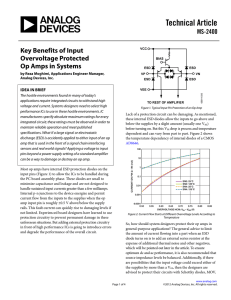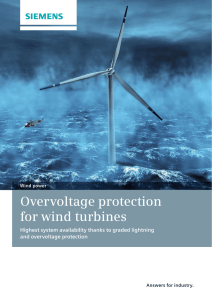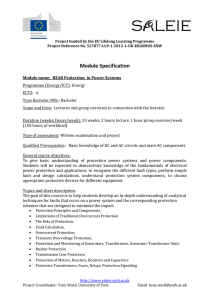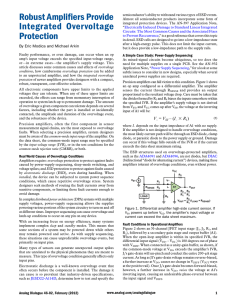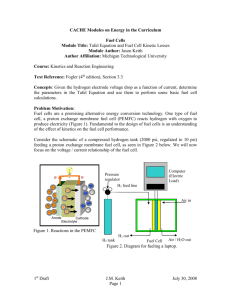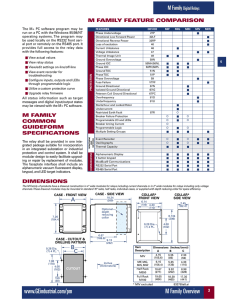AN-1387 APPLICATION NOTE
advertisement
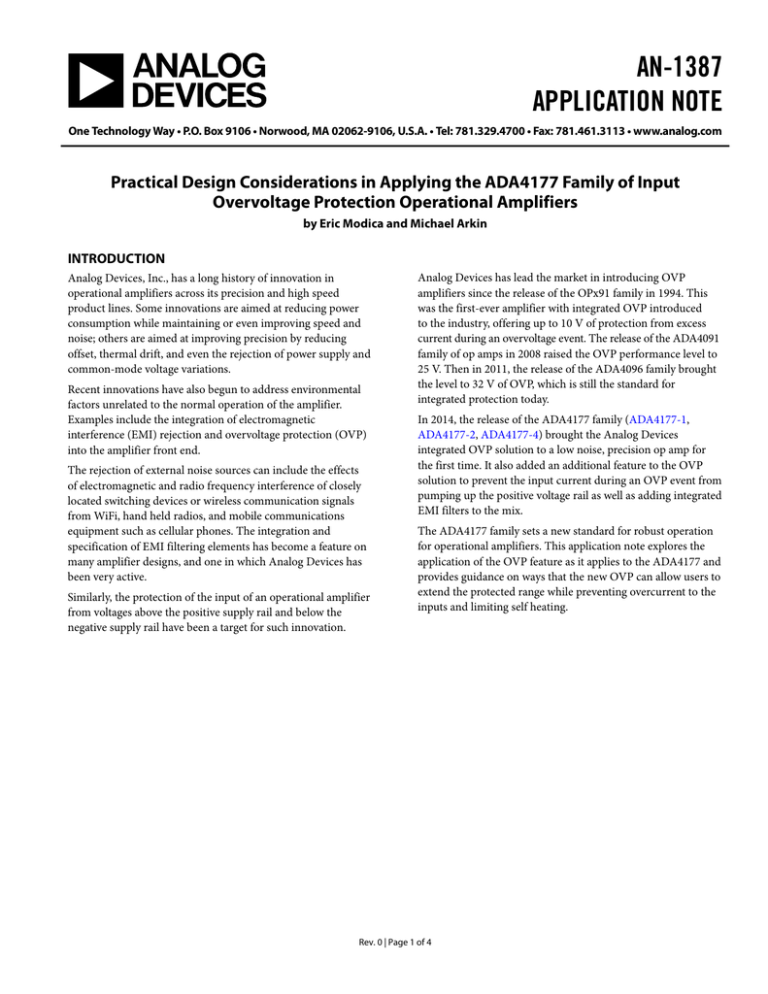
AN-1387 APPLICATION NOTE One Technology Way • P.O. Box 9106 • Norwood, MA 02062-9106, U.S.A. • Tel: 781.329.4700 • Fax: 781.461.3113 • www.analog.com Practical Design Considerations in Applying the ADA4177 Family of Input Overvoltage Protection Operational Amplifiers by Eric Modica and Michael Arkin INTRODUCTION Analog Devices, Inc., has a long history of innovation in operational amplifiers across its precision and high speed product lines. Some innovations are aimed at reducing power consumption while maintaining or even improving speed and noise; others are aimed at improving precision by reducing offset, thermal drift, and even the rejection of power supply and common-mode voltage variations. Recent innovations have also begun to address environmental factors unrelated to the normal operation of the amplifier. Examples include the integration of electromagnetic interference (EMI) rejection and overvoltage protection (OVP) into the amplifier front end. The rejection of external noise sources can include the effects of electromagnetic and radio frequency interference of closely located switching devices or wireless communication signals from WiFi, hand held radios, and mobile communications equipment such as cellular phones. The integration and specification of EMI filtering elements has become a feature on many amplifier designs, and one in which Analog Devices has been very active. Similarly, the protection of the input of an operational amplifier from voltages above the positive supply rail and below the negative supply rail have been a target for such innovation. Analog Devices has lead the market in introducing OVP amplifiers since the release of the OPx91 family in 1994. This was the first-ever amplifier with integrated OVP introduced to the industry, offering up to 10 V of protection from excess current during an overvoltage event. The release of the ADA4091 family of op amps in 2008 raised the OVP performance level to 25 V. Then in 2011, the release of the ADA4096 family brought the level to 32 V of OVP, which is still the standard for integrated protection today. In 2014, the release of the ADA4177 family (ADA4177-1, ADA4177-2, ADA4177-4) brought the Analog Devices integrated OVP solution to a low noise, precision op amp for the first time. It also added an additional feature to the OVP solution to prevent the input current during an OVP event from pumping up the positive voltage rail as well as adding integrated EMI filters to the mix. The ADA4177 family sets a new standard for robust operation for operational amplifiers. This application note explores the application of the OVP feature as it applies to the ADA4177 and provides guidance on ways that the new OVP can allow users to extend the protected range while preventing overcurrent to the inputs and limiting self heating. Rev. 0 | Page 1 of 4 AN-1387 Application Note ADA4177 CURRENT LIMITING VS. NO CURRENT LIMITING PROTECTING POWER SUPPLIES DURING OVERVOLTAGE EVENTS Figure 1 shows a test circuit used to measure the input current of the ADA4177 during an overvoltage event. The amplifier is placed in unity gain, and the positive input is swept 15 V above and below the supplies while measuring the input bias current. One common method of protecting op amp inputs from overvoltage is to use small signal or Schottky diodes connected from an input pin to both the positive and negative power supply; this method is shown schematically in Figure 3. The turn-on voltage of the Schottky diode is 0.4 V, which is approximately 0.2 V lower than that of a small signal diode. This relative difference prevents the internal ESD diodes of the op amp from turning on when an overvoltage event occurs. VIN 13819-001 A V– Figure 1. Circuit to Test Overvoltage Current Limiting Figure 2 shows the results of this measurement for both the ADA4177 as well as those of a standard precision op amp tested with 5 V power supplies. Notice that at 20 V, the ADA4177 input current is one third that of the standard op amp. If the user wants to limit the input current further, an external series resistor can be added. Adding this resistor increases the input noise of the system by the rms summation of the resistor thermal noise and the amplifier input noise. The ADA4177 noise specification includes the minimal contribution of the internal overvoltage circuitry. Adding the ROVP resistor provides an additional current limiting element at the expense of increased thermal noise. A detailed analysis of this solution and its limitations is provided in the technical article, “Robust Amplifiers Provide Integrated Overvoltage Protection”. VCC RF D2 VOUT ROVP VIN D1 13819-003 V+ 30 VEE Figure 3. ROVP, D1 and D2 Providing Input Overvoltage Protection This solution functions by routing current away from the inputs of the op amp. However, when the current is injected into the supplies, the appropriate solution then depends on the application and circuit involved. If the supply is a low dropout (LDO) regulator, VCC and VEE are likely only designed to route current in one direction. Figure 4 shows a typical conceptual schematic of a low dropout regulator where the output voltage is determined by 10 JFET PROTECTED AMPLIFIER –10 VSY = ±5V –20 –30 –20 RESISTIVE PROTECTED AMPLIFIER –15 –10 VOUT = VREF × –5 0 VIN (V) 5 10 15 20 R1 + R2 MP1 VIN Figure 2. ADA4177 Input Current Limiting vs. an Unprotected Op Amp with 500 Ω Discrete Resistors R2 VOUT VREF R1 R2 GND 13819-004 0 13819-002 INPUT BIAS CURRENT (mA) 20 Figure 4. Conceptual Schematic of a Low Dropout Regulator Rev. 0 | Page 2 of 4 Application Note AN-1387 12.5 MP1 is a series pass PMOS transistor that is designed to increase the amount of current that the supply can source. It is inferred that VOUT is not designed to sink current. Therefore, if the overvoltage protection shown in Figure 3 injects current into the supply, that current passes through the R1 and R2 divider, which raises the supply linearly with overvoltage. 10.0 7.5 5.0 IB (mA) If the overvoltage occurs with the supplies powered up, the supply voltage can exceed the intended operating voltage of the system. If the overvoltage occurs with the system powered down, the OVP current can unintentionally power up the system. The ADA4177 has internal circuitry that prevents a positive overvoltage from pumping the supplies. –7.5 –10.0 –15.0 –50 –40 –30 –20 –10 0 10 20 30 40 13819-006 VSY = ±15V –12.5 50 VCMI (V) J1B Figure 6. Input Current During Positive and Negative Overvoltage Conditions Figure 5. Conceptual Schematic of the ADA4177 Input Protection Figure 5 shows a conceptual schematic of the positive input on the ADA4177. If VIN exceeds VCC, the current-limiting FET, J1B, sources the overvoltage current into the emitter of QP1. This current is divided down via the current gain (or β) of QP1 such that the overvoltage current is routed to the negative supply rather than to the positive supply. If all inputs are likely to experience simultaneous overvoltage for long periods of time (>500 ms), it is important to use a limiting resistor in series with the inputs. This resistor not only extends the overvoltage range of the device, but also shares the power burden during an overvoltage event. Figure 7 shows the power dissipation of the ADA4177-4 during a 32 V overvoltage event applied to only two positive inputs and with all four positive inputs simultaneously. Figure 7 shows a plot of the power dissipation of the ADA4177 with two and four inputs overvoltaged by 32 V vs. an additional input series resistance. 1.0 EXTENDING THE INPUT OVP PROTECTION RANGE AND MINIMIZING SELF-HEATING DURING OVP EVENTS WITH CURRENT LIMITING RESISTORS POWER DISSIPATION (W) 0.8 The ADA4177 inputs are equipped with current-limiting JFETs. These JFETs limit current into the amplifier during an overvoltage or differential fault, and improve the robustness and reliability of the device. However, to keep the input noise to a minimum during normal operation, these FETs must be large. With a θJA of 158 W/°C, the temperature increase is approximately 12°C. If the ADA4177-4 is being used with a possibility of all control inputs being exposed to an overvoltage condition for an indefinite time, power dissipation can quickly raise the junction temperature above the maximum of 150°C. 4 INPUTS, 32V OF OVERVOLTAGE 0.4 0.2 2 INPUTS, 32V OF OVERVOLTAGE The engineering tradeoff associated with this is that the current limit may not be as low as is needed for all applications. As shown in Figure 6, the positive input sinks approximately 7.5 mA with 10 V of overvoltage (OV). The power dissipation (PD) is calculated as follows: PD = 10 V × 7.5 mA = 7.5 mW 0.6 0 0 2 4 SERIES RESISTANCE (kΩ) 6 13819-007 VEE 13819-005 J1A 0 –2.5 –5.0 VCC VIN+ IB– IB+ 2.5 Figure 7. Power Dissipation of the ADA4177-4 During Overvoltage Figure 8 shows the temperature rise of the ADA4177-4 during the same overvoltage event using an assumed θJA of 158 W/°C to calculate the increase in die temperature; it is plotted in the same way as the power dissipation shown in Figure 7. Rev. 0 | Page 3 of 4 AN-1387 Application Note 200 REFERENCES TEMPERATURE INCREASE (°C) ADA4177-4 product page and data sheet ADA4177-2 product page and data sheet 150 ADA4177-1 product page and data sheet Modica, Eric and Michael Arkin. “Robust Amplifiers Provide Integrated Overvoltage Protection.” Analog Dialogue, 46-02, February 2012. 100 4 INPUTS, 32V OF OVERVOLTAGE 50 REVISION HISTORY 2 INPUTS, 32V OF OVERVOLTAGE 0 0 2 4 6 SERIES RESISTANCE (kΩ) 13819-008 12/15—Revision 0: Initial Version Figure 8. Temperature Rise of the ADA4177-4 During Overvoltage For example, inserting a 2 kΩ resistor in series with the positive input halves the power dissipation of the ADA4177 during an overvoltage event and adds only approximately 1 nV/Hz of noise to the system during normal operation. Adding this resistor limits the temperature rise during overvoltage events. Without this resistor, the temperature rise can reach approximately 150°C when all four inputs are exposed to overvoltage; with the external resistor, the temperature rise is limited to approximately 75°C. Similarly, if two inputs are exposed to overvoltage, the temperature rise can reach approximately 70°C without the resistor; with the resistor, the temperature rise is limited to 40°C. In addition, the overvoltage protected range is increased from 32 V to 50 V because the external resistor shares some of the overvoltage burden. ©2015 Analog Devices, Inc. All rights reserved. Trademarks and registered trademarks are the property of their respective owners. AN13819-0-12/15(0) Rev. 0 | Page 4 of 4

